- This compilation of scholarly thoughts tells about Lord Indra in Buddhism and his worship in many countries.
When
I visited Bangkok was surprised to see a temple on Sukumwit Street i.e.
dedicated to Lord Indra. It was next to a Brahma Temple, the Erawan shrine.
When I attended the Siam
Niramit Cultural Show (see pic 8) at Bangkok there too was a reference to
Lord Indra and Buddha.
In India we treat Indra as a Hindu God so was left wondering. When I asked this question to art historian Benoy K Behl he said, “The earliest-known representation of Lord Indra is of the 2nd century BCE in the Buddhist caves of Bhaja in Maharashtra. Indra continues to be in worship in every Buddhist temple of Japan. Please see my book, 'Hindu Deities Worshipped in Japan'. In ancient times, there were no separate religions of Hinduism and Buddhism in India.” Bhaja Caves were made around 2nd century BCE.
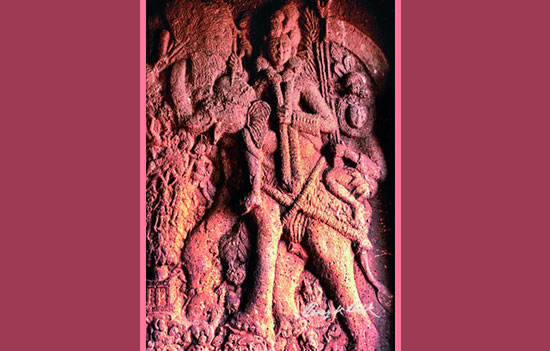 Earliest depiction of Lord Indra, Bhaja Caves, Maharastra. Pic by Benoy K Behl.
Earliest depiction of Lord Indra, Bhaja Caves, Maharastra. Pic by Benoy K Behl.
 Lord Indra on an Elephant, Bhaja Caves Maharashtra.
Lord Indra on an Elephant, Bhaja Caves Maharashtra.
Hindu
Buddhist distinctions are being spoken about often since the start of the
colonial era and esp. after Ambedkar became Buddhist around 1955. In Thailand, Ganesha
is worshipped and in Japan, Indra is worshipped by Buddhists.
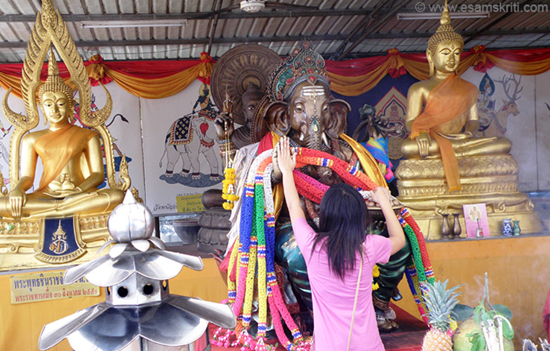 Ganesha being worshipped in Thailand.
Ganesha being worshipped in Thailand.
Also read The
Hindu Gods of Buddhist Thailand
What about Indra in Buddhism?
Scholar
and esamskriti author Sanjay Rao wrote that, “According to the ancient Indian writings in the Rig Veda, He is the most significant heroic deity. In Buddhism this deity is supposed to live in Kiken castle as the lord of the realm of Tory ten. He is considered to have helped Buddha in his novitiate years. In Hinduism Indra is the god of the lesser heavens where ordinary mortals reside for limited periods of time in their endless cycles of birth and death.”
Well-known author Devdutt
Patnaik wrote in Mumbai Mirror, “In Buddhist lore, he is present when the Buddha is born and when the Buddha becomes the Buddha, i.e. attains enlightenment and he encourages Buddha to spread his wisdom to humanity.”
Indic scholar, Author and
Researcher Rajiv Malhotra wrote in Indra's Net, “The metaphor of Indra’s Net originates from the Atharva Veda which likens the world to a net woven by the great deity Shaka or Indra.” Pg.
4 He adds, “The Avatamsaka Sutra (which means Flower Garland) of Mahayana Buddhism use the metaphor of Indra’s Net to explain cosmic interpenetration.” Pg. 13
Rajiv also wrote in Firstpost.com, “It is obvious that Indra is a Vedic deity. This is how I discovered that Buddhism first elaborates on this metaphor in the Avatamsaka sutra, and that this Buddhist sutra was adopted from the Vedas.”
Prof Shashi Bala, Dean, K M Munshi Centre of Indology, Bharatiya Vidya Bhavan, New Delhi writes, “Why Lord Indra, a Vedic deity was taken into the fold of Buddhism, was never a question in the minds of the Buddhists all over Asia. It was the philosophy of transcendence in life that lays behind it.”
“My Ph.D thesis was on the “Twelve Vedic Deities in Japanese Buddhist Pantheon, A Comparative Study with Sanskrit Literary Sources”. The group is called Juniten in Japan, meaning twelve deities. Indra, the first among them, is portrayed in several manifestations in Japanese temples and monasteries over the past 1400 years and is still worshipped in Shingon temples. So far as my knowledge goes, there are some forms in Japan that are described but not painted or sculpted in India. Indra is differently portrayed in Vedic and Puranic literature. Buddhism has absorbed both of them.”
“Indra is present in Buddhist art in several
forms in Asian countries. He has been worshipped in Nepal, China, Manchuria, Japan, Korea, Mongolia, Tibet and even in Central Asia by the Uighurs. He has been painted, sculpted, and drawn for over more than a millennium. His statues and paintings can be found in the Yunkang caves, the Guge thangkas, Japanese scrolls, Mongolian and Tibetan xylographs.”
“The major characteristics and symbolism of Indra remain similar. His heavenly abode Sudarshana in Tushita heaven is called Kenzenjo in Japan which means a place of perfect/right vision. His responsibility is to listen to the moral condition of the people.”
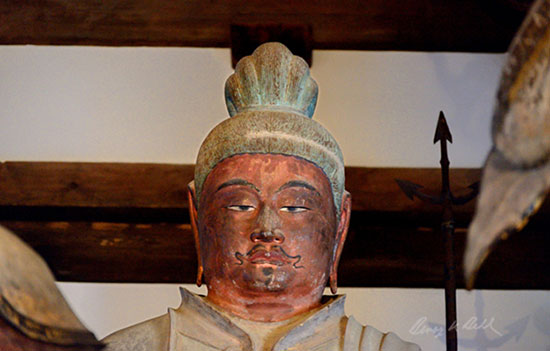 Lord Indra, Todaji Temple, Hokkedo Hall, Nara. Pic by Benoy K Behl.
Lord Indra, Todaji Temple, Hokkedo Hall, Nara. Pic by Benoy K Behl.
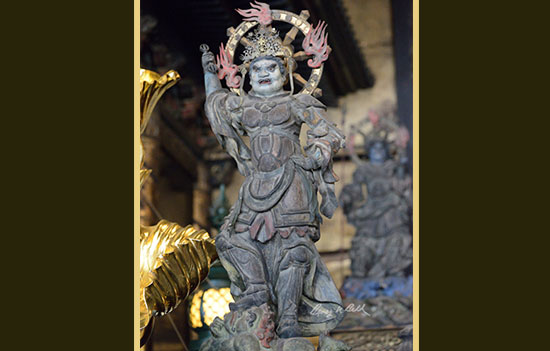 Indra, Gokuji, Tokyo. Pic by Benoy K Behl.
Indra, Gokuji, Tokyo. Pic by Benoy K Behl.
“In Buddhist art he is represented both with a third eye and without it. The main attribute is a Vajra. He sits on an elephant called Airavata, as found at Toji monastery in Japan. As the lord of lords of 33 heavens, he sits on Mount Sumeru in the north. As the lord of the heavenly sphere, he is flanked by Brahma who is the lord of earth.”
“His association with Lord Buddha begins
from the time of his birth. Buddha had cut down his hair and pronounced his vow in the presence of Brahma and Indra. When Buddha steps down the ladder coming from the Trayastimsha heaven, Indra stands with Brahma.”
“In India, the human mind wished sanctification and protection in all the directions assigned to the ten divine guardians. Indra is one of them. The idea of divine protection percolated into Buddhism. As one of the ten guardians of directions, he sits in the east looking vigilant and holding a staff.”
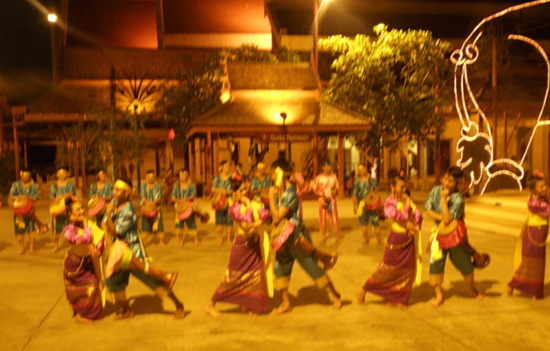 Siam Niramit Show Bangkok, “In the 3 Realms scene “Ascent to Daow-wa-dueng, the second level of heaven, where Indra, the greatest deity of all presides.”
Siam Niramit Show Bangkok, “In the 3 Realms scene “Ascent to Daow-wa-dueng, the second level of heaven, where Indra, the greatest deity of all presides.”
“In Southeast Asia, kings ruled as divine incarnations of Chakravarti Devaraja Indra. The people in Cambodia and Thailand, performed Vedic coronation rites called Aindrabhisheka, to rule as a chakravartins. The place where Jayavarman II of Cambodia went for coronation was Mahendra parvata (=Maha+Indra). It was a pyramidal structure raised as the symbolic centre of the kingdom. According to folk legend Jayavarman II derived his power from India.”
“Generally Indra holds a Vajra but in Mongolia he can be seen as holding a conch, manifesting as Devendra
Shatakratu, as of the ten guardians of directions he sits in the east.”
“The Buddhist texts like Nishpannayogyavali
and Dharmaroshasangraha give his iconographical descriptions.”
So
what is clear is that Lord Indra, a Vedic deity, helped Buddha and is
worshipped in many Asian countries.
Also read
1.
Hindu
Symbols in Thailand
2.
Harmonious
blend of Hindu, Buddhist and Shinto stands in Japan
3.
Hindu
Temples in Bangkok
4.
Siam
Niramit Show
Devdutt Patnaik wrote in Mid-day, “In Jainism, Indra takes the form of the care-taker of the wise sages known as Tirthankars. Indra and his wife, Indrani, who is also mentioned in the Rig Veda, stand on either side of the Tirthankara, in positions of veneration. We are told that Indra is present at the time of each Tirthankar’s birth, the time he renounces the world, when he attains Kevala Jnana or omniscience, when he gives his discourses and when he, finally, rises to Siddhaloka.”